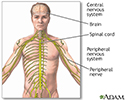Hyperactivity
Activity - increased; Hyperkinetic behaviorHyperactivity means having increased movement, impulsive actions, a shorter attention span, and being easily distracted.
Considerations
Hyperactive behavior usually refers to constant activity, being easily distracted, impulsiveness, inability to concentrate, aggressiveness, and similar behaviors.
Typical behaviors may include:
- Fidgeting or constant moving
- Wandering
- Talking too much
- Difficulty participating in quiet activities (such as reading)
Hyperactivity is not easily defined. It often depends on the observer. Behavior that seems excessive to one person may not seem excessive to another. But certain children, when compared to others, are clearly far more active. This can become a problem if it interferes with school work or making friends.
Hyperactivity is often considered more of a problem for schools and parents than it is for the child. But many hyperactive children are unhappy, or even depressed. Hyperactive behavior may make a child a target for bullying, or make it harder to connect with other children. Schoolwork may be more difficult. Kids who are hyperactive are frequently punished for their behavior.
Excessive movement (hyperkinetic behavior) often decreases as the child grows older. It may disappear entirely by adolescence.
Causes
Conditions that may lead to hyperactivity include:
-
Attention deficit hyperactivity disorder (ADHD)
Attention deficit hyperactivity disorde
Attention deficit hyperactivity disorder (ADHD) is a problem caused by the presence of one or more of these findings:Not being able to focusBeing ove...
Read Article Now Book Mark Article - Brain or central nervous system disorders
Central nervous system
The central nervous system is composed of the brain and spinal cord. Your brain and spinal cord serve as the main "processing center" for your entir...
 ImageRead Article Now Book Mark Article
ImageRead Article Now Book Mark Article - Emotional disorders
- Over-active thyroid (hyperthyroidism)
Hyperthyroidism
Hyperthyroidism is a condition in which the thyroid gland makes too much thyroid hormone. The condition is often called overactive thyroid.
 ImageRead Article Now Book Mark Article
ImageRead Article Now Book Mark Article
Home Care
A child who is normally very active often responds well to specific directions and a program of regular physical activity. But, a child with ADHD may have a hard time following directions and controlling impulses.
When to Contact a Medical Professional
Contact your child's health care provider if:
- Your child seems hyperactive much of the time.
- Your child is very active, aggressive, impulsive, or has difficulty concentrating.
- Your child's activity level is causing social difficulties, or difficulty with schoolwork.
What to Expect at Your Office Visit
Your provider will perform a physical exam of your child and ask about your child's symptoms and medical history. Examples of questions include whether the behavior is new, if your child has always been very active, and whether the behavior is getting worse.
Your provider may recommend a psychological evaluation. There may also be a review of the home and school environments.
References
Castillo JMV. Psychiatry. In: Anderson CC, Kapoor S, Mark TE, eds. Harriet Lane Handbook, The. 23rd ed. Philadelphia, PA: Elsevier; 2024:chap 24.
Chaves-Gnecco D, Feldman HM. Developmental/behavioral pediatrics. In: Zitelli BJ, McIntire SC, Nowalk AJ, Garrison J, eds. Zitelli and Davis' Atlas of Pediatric Physical Diagnosis. 8th ed. Philadelphia, PA: Elsevier; 2023:chap 3.
Harstad EB. Attention-deficit/hyperactivity disorder. In: Kliegman RM, St. Geme JW, Blum NJ, et al, eds. Nelson Textbook of Pediatrics. 22nd ed. Philadelphia, PA: Elsevier; 2025:chap 50.
-
Central nervous system and peripheral nervous system - illustration
The central nervous system comprises the brain and spinal cord. The peripheral nervous system includes nerves outside the brain and spinal cord.
Central nervous system and peripheral nervous system
illustration
-
Attention deficit hyperactivity disorder - InDepth
(In-Depth)
-
Attention deficit hyperactivity disorder
(Alt. Medicine)
Review Date: 4/1/2024
Reviewed By: Charles I. Schwartz, MD, FAAP, Clinical Assistant Professor of Pediatrics, Perelman School of Medicine at the University of Pennsylvania, General Pediatrician at PennCare for Kids, Phoenixville, PA. Also reviewed by David C. Dugdale, MD, Medical Director, Brenda Conaway, Editorial Director, and the A.D.A.M. Editorial team.



